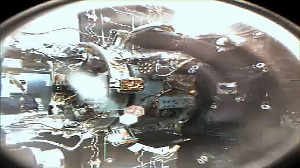 Indian Navy's ships and submarines were involved in 38 accidents between 2007-08 and 2015-16, adversely affecting the operational preparedness of the force, the Comptroller and Auditor General said in a report on Friday.
Indian Navy's ships and submarines were involved in 38 accidents between 2007-08 and 2015-16, adversely affecting the operational preparedness of the force, the Comptroller and Auditor General said in a report on Friday.
The auditor said the accidents were primarily attributable to fire, explosion and flooding, adding the Navy had no institutionalised framework to deal with safety since its inception.
The report, tabled in the Parliament, said a dedicated organisation for dealing with safety issues was setup by the Indian Navy in 2014. However, it awaits government's sanction.
The auditor said the loss of a ship and submarine adversely affects the operational preparedness of the Navy as acquisition of new ships and submarines takes more than eight to 10 years.
'It is, therefore, imperative that Navy maintains its assets free from accidents during peacetime evolutions.
'Between 2007-08 and 2015-16, Indian Navy ships and submarines were involved in 38 accidents, primarily attributable to fire, explosion, flooding,' the CAG said.
The CAG also observed that the inventory control mechanism in the Navy was deficient and that laid down timeline for processing of indents was not adhered to leading to cascading effect in procurement of stores.
The also found that the Navy, while placing the order for procurement of four aero-engines for two helicopters damaged in an accident, did not take into consideration one helicopter which was declared 'Beyond Economical Repairs' before the conclusion of the contract.
It said the lapse in decision making process resulted in unproductive expenditure of Rs 16.62 crore on the procurement of three excess aero-engines.
The CAG also said that non-availability of the defence systems on board the fleet tankers, since their delivery in 2011, rendered them vulnerable to external threats.
Further, non-linking of payment with the supply/installation of vital defence systems for two fleet tankers, resulted in premature payment of Rs 26.73 crore to the foreign vendor.
The CAG said the UH-3H fleet of helicopters, procured as an integral part of Landing Platform Deck, was unable to maintain the desired levels of serviceability in six out of seven years of its operations since commissioning.
It said non-existence of dedicated depot level maintenance facilities and non-availability of spares adversely impacted the maintenance of the fleet.
'Further, Navy continues to be dependent on the foreign repair agency for maintenance, servicing and logistics issues due to lack of training of Naval personnel,' the CAG observed.
In another finding, the CAG said non-availability of a critical flight safety equipment on board the Indian Navy's and Coast Guard's aircraft, has impacted their safe operation for the past 12 years.
"The situation would persist for another four years due to asynchronous timelines for delivery of the equipment and its installation on board the aircraft.
'Further, failure to take cognisance of de-induction of one of the aircraft fleet, resulted in excess procurement of 10 equipment worth Rs 5.58 crore,' the CAG said.
'Leakage of oxygen reason behind Sindurakshak explosion'
Indian Navy's frontline submarine INS Sindurakshak had exploded in 2013 in Mumbai due to leakage of oxygen from a torpedo, the CAG said, revealing the reasons causing the major accident.
The CAG cited the report of a high-level inquiry by the Navy into the explosion on board the submarine on Aug 14, 2013 following which it had sunk. The accident is considered one of the biggest in recent times for the Navy in which 17 personnel were killed.
'In February 2014 after scientific analysis and careful consideration, inferred leakage of oxygen from a torpedo as a primary initiator of the incident. The oxygen leak was attributed to material failure of oxygen flask or its associated pipelines,' the CAG said.
It said complete 'Work Up' of the submarine was not conducted when the submarine was prepared for operational deployment as the 'Work Up' was completed within one week instead of prescribed two weeks.
The CAG report was tabled in Parliament on Friday.
The CAG said most of the recommendations made by the Boards of Inquiry into explosion on the submarine emphasised the need for strict adherence to the existing standard operating procedures.
The report also said that smoke and fire detectors were not installed in all compartments of the submarine for warning.
'There were two incidents of fire in the submarine within a span of two hours. The occurrence of two fire incidents in the same compartment of the submarine within a span of about two hours is indicative of the fact that in all likelihood, the first fire in the compartment was not extinguished completely,' the report said.
The CAG also cited a number of accidents involving the Navy's ships and submarines.











 © 2025
© 2025